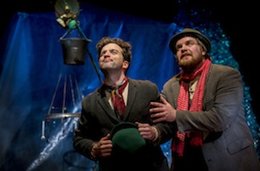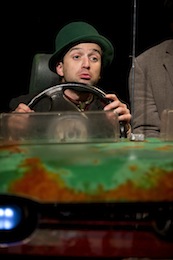“Do you know what 'bockety' means? It's something that's a little bit broken, a little bit wobbly, but it still kind of works.”
Barnstorm Theatre Company presents a charming production for young audiences in which they explore the ups and downs of friendship, and what happens when something goes wrong. Written in Beckettian style sparse and absurdist language, best friends Henry and Bucket are reminiscent of Waiting for Godot's Vladimir and Estragon (as echoed in Carol Betera’s costume choices), although Barnstorm's characters are a lot more relatable and are full of a childlike sense of fun and imagination.
 Best friends Henry and Bucket live in a scrapheap, but have managed to make a home out of very humble surroundings. Their day consists of routine activities such as having a shower under an umbrella, collecting breakfast with a metal detector and heating it up with an iron plugged into a shoe, and taking care of their pet mouse (which is, humorously, a computer mouse). Although the friends are very similar, and go about their morning routines in complete synchronicity, they also have different interests, which can sometimes lead to arguments: “You – Are – Getting – On – My – Nerves – Today!” Henry and Bucket have to work through their differences and remember why they are friends, so they can carry on living in their bockety world together.
Best friends Henry and Bucket live in a scrapheap, but have managed to make a home out of very humble surroundings. Their day consists of routine activities such as having a shower under an umbrella, collecting breakfast with a metal detector and heating it up with an iron plugged into a shoe, and taking care of their pet mouse (which is, humorously, a computer mouse). Although the friends are very similar, and go about their morning routines in complete synchronicity, they also have different interests, which can sometimes lead to arguments: “You – Are – Getting – On – My – Nerves – Today!” Henry and Bucket have to work through their differences and remember why they are friends, so they can carry on living in their bockety world together.
Henry's and Bucket's world is comprised of a miscellany of discarded recyclables. The backdrop is a collection of bottles and cans, to which Henry and Bucket meticulously add their empty breakfast cans, as if assembling a Jenga tower. The set, expertly designed by Carol Betera, consists of a rusty fridge supporting a mouse cage; a ladder leading nowhere, off which hangs a homemade chandelier of wrenches; two tyres which make Henry's and Bucket's beds, covered by plastic sheets; and assorted rubbish and cleverly hidden lamps which surround the stage. A miniature of the set is surreptitiously hidden in an old computer monitor at the front of the stage, only visible upon careful examination of the scene, and the starry backdrop at the play's close, along with impressive lighting design by Mark Galione, enhances the atmosphere of magic which pervades the piece. The sound and music design (Jack Cawley) transports the characters from one world to another, even though the set remains unchanged, as they journey “straight ahead” and “up!” in their makeshift car, animating the stories they imagine, and transforming ordinary household objects into something truly magical. The characters' shabby yet colourful costumes of torn jackets, trousers and bowler hats, and whimsical ties and waistcoats (Betera) add significantly to the comedy element of the production.
 Sarah Argent's use of sparse text is a brave choice for a production in a country where storytelling is such an integral part of the culture, but the play's resulting dependence on the physicality of the actors as the driving force of the play leads to a Mr Bean-like physical comedy and a delightful relationship between the two actors that has the audience (both young and old) grinning from start to finish. Actors John Currivan and Paul Curley effortlessly seduce the audience into their world of imagination, where a car bonnet, two tyres, and a couple of chairs become a gateway to the moon, and anything is possible.
Sarah Argent's use of sparse text is a brave choice for a production in a country where storytelling is such an integral part of the culture, but the play's resulting dependence on the physicality of the actors as the driving force of the play leads to a Mr Bean-like physical comedy and a delightful relationship between the two actors that has the audience (both young and old) grinning from start to finish. Actors John Currivan and Paul Curley effortlessly seduce the audience into their world of imagination, where a car bonnet, two tyres, and a couple of chairs become a gateway to the moon, and anything is possible.
The collaborative devising process between Argent and Barnstorm has clearly paid off, as it is the attention to detail and the visible dedication and enjoyment of the cast that make The Bockety World of Henry and Bucket a stand-out piece of children's theatre.
Helen Cusack has a BA (Hons) in Drama Studies and English Literature and a Masters in Children's Literature from Trinity College Dublin.